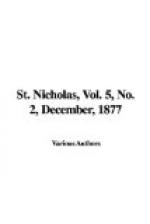Although the lamb follows its mistress everywhere, school is a tabooed place. Yet the little creature cannot live without Mary, who has departed fair and fresh as Overbury’s “Happy Milkmaid.” Long are the hours that must elapse ere Mary’s return, and the lamb tires of the waiting. “It followed her to school one day.” How innocent an act that seems!—how natural! Then we read the next line,—“Which was against the rule,” and the lamb’s action is turned from innocence to guilt. Mary’s favorite, that we have seen heretofore in only a good light, violates deliberately a rule of the school which Mary attends. The short sight of the animal’s spiritual eyes prevents it from knowing the extent of the disgrace to which it is to be subjected. At present the end justifies the means in its little heart, and it leaves its pleasant home to wander schoolward, and we are left to imagine its thoughts on the way.
A scene in the school-house bursts upon us, and
“It makes the
children laugh and play
To see a lamb
at school.”
This is another instance in which we are shown the poet’s knowledge of human nature. At anything less than the sight of a lamb the little scholars are too well trained to laugh. This has no precedent. They have been told how to behave should a dog enter the room, or should a ludicrous error in lessons occur; but when a lamb trots soberly in,—not gamboling now; conscience already whispers; remorse eats at the little creature’s peace of mind,—it is not to be expected that order can be longer maintained, and the school, with the exception of Mary, runs riot. Mary is perhaps, meanwhile, reproaching her pet with a look “more in sorrow than in anger;” she is too gentle to scold, but that glance completely fills the lamb’s cup of sorrow; it is yet to overrun, and the drop is soon poured in—the deep beneath “the lowest deep” is soon reached.
“For this the teacher turned him out.”
It was his duty, reader; judge him not harshly.
“But still he lingered near.”
This, at least, was not forbidden,—to wait for his little mistress.
“And waited patiently
about
Till Mary did
appear.”
How fraught with significance is that one word, “patiently!” All too eager before, that was the lamb’s fault, “and grievously hath [he] answered it.” He has turned over a new leaf, and wandering aimlessly about, now nibbling a cowslip, now rolling in the young grass to still the remorse gnawing at his heart, we can imagine him resolving to be a better lamb in the future,—to grow more worthy Mary’s love.
“‘What makes
the lamb love Mary so?’
The eager children
cry.”
All have noticed this devotion—all wonder at it. The teacher answers in words that prove how well we read Mary’s affectionate nature:
“‘Why, Mary
loves the lamb, you know,’
The teacher did
reply.”




